Are Scottish Terriers the Breed for You?
>
But, are Scottish Terriers the best breed for you?
By Janice Jones |Last Updated November 21, 2019
You might hear the Scottish terrier referred to as the
Scottie or just plain Scot because that is the location of the origin of this
breed.
They sport a beautiful terrier
coat that consists of a hard, wiry, and weather resistant outer coat and a soft
inner coat.

The classic look of a well-groomed
Scottie includes a distinctive beard,
long eyebrows, longer hair on his legs and lower body and an upper body that is
short.
These dogs are strong, fast, and alert, yet gentle and
loving. Bred and trained originally to
hunt and kill vermin, they are now usually house pets. While not considered high maintenance dogs,
they do require regular grooming. Their
coat needs frequent brushing and clipping to maintain the classic look.
Basic obedience training is necessary for this breed, and
should begin as soon as the puppy arrives in your home. These dogs are quick, have a strong prey instinct,
and have that classic terrier spirit in them, Your puppy’s behaviors may seem
cute now, but not as desirable, once a dog reaches adulthood. Early socialization is also a must for
Scotties
These dogs excel in a variety of canine sports including
agility, flyball, earth dog rally
obedience and conformation should you decide to purchase a potential show
puppy.
Quick Facts About the Scottish Terrier

8.5 to 10 kg 18-22 lbs.

25 cm
9.8 inches

11-13 Years

Terriers

Scotland
Other Names Used: Scottie, Scot, Diehard (nickname)
Affiliation: AKC, CKC, UK: Terrier Group
Coat Type: Harsh, Wiry Outer Coat, Soft inner coat
Colors: Black, Brindle, Wheaten
Activity Level: Moderately Active
Good with Children: Yes
Good with other pets:
At their best as “only” children, however…
If raised together, they usually do fine with other dogs;
beware of small pets such as hamsters, gerbils or mice as the Scottie has a
very strong prey drive and may mistake a household pet for prey.
Average Litter Size: 1-6
Average Price: $1000-1500
History of Scottish Terriers
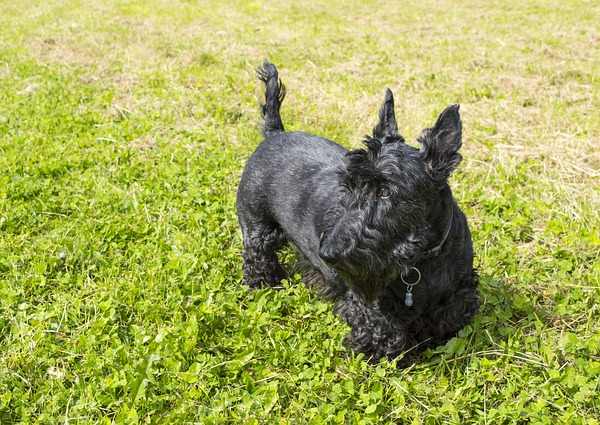 Scottish Terrier Breed Profile
Scottish Terrier Breed ProfileThe Scottish terrier traces his history back to the
highlands of Scotland. Many believe that
is breed is the oldest originating in Scotland and possibly one of the original
terrier breeds and may have been around even during Roman times.
Called Skye Terriers at the time, they were bred and kept by
hunters and farmers to find and kill vermin.
Four other Scottish terrier breeds include the Skye, West Highland white
terrier, the Cairn terrier and the Dandie Dinmont Terrier was grouped together
with the Scottish terrier.
Breeding
decisions were made solely for a dog’s ability to do the job needed, and little
attention was given to appearance. In
this case, the Scottish needed a dog that was sturdy, fearless, and able to
tolerate the harsh Scottish climate.
At some point in the
late 1880s, they entered into English shows.
It was then that a breed standard was written, and the Scottish Terrier
Club of England was formed in 1883. By
the 1890s, Scotties were being imported into the United States and then in
1990, the first AKC standard was drawn up, based on the standard of the Scottish
Terrier Club of Scotland.
The years
between the two great wars saw the greatest increase in popularity and their
popular has waxed and waned over the years.
In 2013, AKC ranked them at number 55 in popularity in the United States.
Personality of Scottish Terriers
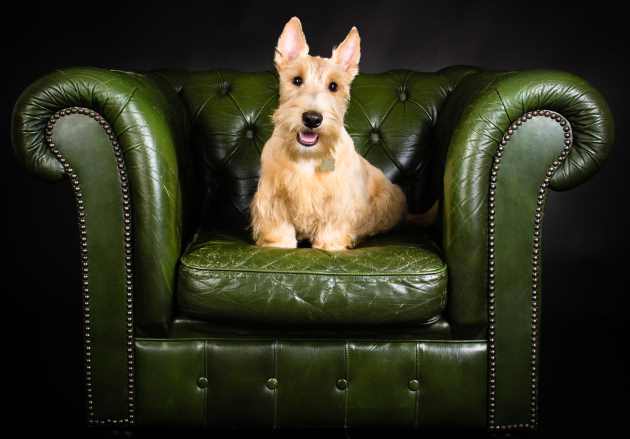 Wheaten Colored Scottish Terrier
Wheaten Colored Scottish TerrierAlthough they may first seem somewhat aloof, their devotion
to their special people or person is the best. Scottish Terriers are very quick, alert and even feisty. Known to be independent and intelligent, they
have an abundance of self-confidence and determination, all characteristic
traits that most members of the terrier group share.
They have a stubborn streak, so training should start early
and continue throughout the lifespan. A
gentle, positive approach to training is most effective. Early socialization is also important to
prevent the dog from dominating the entire household and becoming wary of strangers. They love to dig, getting this trait early on
in their history because they were trained to hunt and fight badgers.
Chasing is another
trait still very visible in the modern Scottish terrier and no squirrel, rat,
or field mouse is safe when a Scottie is near.
They are at their best with a daily dose of exercise and play.
They adapt well to colder climates and prefer cool climates
and snow to hot, humid areas.
Playful as puppies and dignified as adults, the Scottie
makes a great watchdog. While not
considered a big barker, they will alert you to someone at the front door.
Grooming
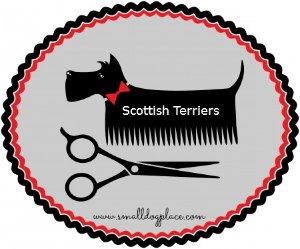
Scottish Terriers need regular brushing and combings especially during
the time that the dog is shedding. Shedding
is not a major problem in this breed, and they are considered to be light
shedders. Their hair does tend to tangle so a once over twice a week is necessary.
As with any double coated breed, brushing
should be done in such a way that it goes down to the skin. A light brushing of the top coat is not
enough to prevent mats from forming.
Scotties require professional grooming is needed to maintain
that classic Scottish terrier look. Hand
stripping twice a year to keep the coat in its best condition is also needed.
Other than that, basic grooming tasks include
keeping the nails trimmed, brushing the teeth, cleaning around the eyes and
face, and a good bath about every 3 or 4 weeks.
Their weather resistant coat usually resists dirt, but if not, a good
brushing will get most dirt out of the coat.
Health Concerns of Scottish Terriers
As with all small breed dogs, Scottish Terriers are relatively healthy. All dogs, big or small are susceptible to infections, worms, and injuries. The list of diseases below are not meant to scare you. They are all genetic or thought to be of genetic origin and have been reported in the breed.
Scottie Cramp
Scottie
Cramp considered the most widespread hereditary problem affecting Scottish terriers is
not serious, and dogs can live a long healthy life, often without
treatment. This condition causes the dog’s
gait to change because of stress such as when the dog is hunting, fighting, or
mating. Some dogs cannot run or walk for
a brief time and then the symptoms simply disappear.
The
cause appears to be either a buildup or a depletion of chemicals in the brain
making the dog uncoordinated. It is
present at birth and is permanent, but does not seem to worsen with age. Treatment is usually not necessary, but if the
dog’s condition is severe, a veterinarian may prescribe Vitamin E, Diazepam, or
Prozac.
Von Willebrand’s Disease
Von Willebrand’s Disease (VWD) is common
in small breed dogs and can occur in humans, pigs, and rabbits. It is a genetic bleeding disorder, less
severe than hemophilia and is passed to offspring by way of an autosomal trait
(inherited by either male or female puppies.
The normal symptoms include excessive
bleeding when the nails are cut into the quick, bleeding from the nose, gums, vagina,
or penis, blood in the stool or urine and even internal bleeding. Sometimes hematomas form on the body; the dog
experiences bloody infected ears, and during surgical procedures, more bleeding
is likely to occur.
Cushing’s Syndrome
Cushing’s syndrome is another common problem
in small breed dogs and also occurs in Scottish Terriers. It consists of a group of symptoms caused by excessive
production of cortisol. Cushing’s
syndrome can be caused by (a) a pituitary tumor, adrenal gland tumor, or from overuse
of corticosteroids.
The main symptoms include excessive
thirst and frequent urination, poor coat, darkening skin, and the appearance of
a little pot belly. Treatment usually
consists of medication taken daily.
Surgery and radiation therapy is rarely done in dogs.
Hypothyroidism
Hypothyroidism occurs when the thyroid
does not produce enough hormones. The
symptoms in a dog include poor coat, chronic skin allergies and infections,
weight gain, infertility, fatigue and intolerance of the cold. Treatment usually consists of a daily pill.
Epilepsy
Some Scotties suffer from seizures. Seizures may be caused by low blood sugar,
brain tumor, heat stroke, poison, nutritional deficiency and distemper.
However, when there are recurrent seizures
that are not associated with a specific disease it is considered to be Classic
or idiopathic epilepsy.
Before treatment can begin, the veterinarian must determine the cause and rule out other disorders that may be causing the Scottish Terrier to seize.
Treatment is needed when the dog begins to have more
frequent or prolonged seizures than previously, and may involve the
administration of phenobarbital, Dilantin, or primidone.
Feeding Scottish Terriers
The Scottish terrier does best on a diet of high quality food based on his age and lifestyle. Since some Scotties are more active than others, it’s important to give just the right number of calories to assure that your Scottie does not gain weight. An average adult of 20 pounds will need about 587 calories. You can determine how much that works out in cups by looking at the food label, but for most foods, it works out to be about 1 to 1 1/2 cups per day spread over two meals.
Chronic allergy problems that result in flaky itchy skin plague some members of this breed. Sometimes these problems stem from food allergies. The most common types of food allergies in dogs are beef, chicken, lamb, pork, rabbit or fish. Wheat, soy, dairy and egg allergies are also common. Choosing a food that contains one protein source may help as well as avoiding foods containing wheat or soy.
Lifestyle
 Scottish Terrier Puppies
Scottish Terrier PuppiesBest Suited for…
Traditionally considered a working breed, Scotties do well as a family companion. They like children but are not always patient around young babies and toddlers. Singles, couples, families and seniors find them to be great companions, but they are independent, so they do best with people willing to understand and tolerate all of their idiosyncrasies.
Though originally bred to be a farm dog, most no longer live on the farm. They do well in apartments as long as they get enough exercise. If living in a home, it is very important that they have a fenced in yard to run and play. They have a very strong prey drive and won’t think twice about leaving their property if there is a squirrel to chase.
Energy and Activity Level
This breed is active and needs plenty of exercise to keep them happy. Since they are an independent breed with a work ethic, they do best when they have a job to do. But routine training commands may not be the best job because they also tend to get bored especially with repetition.
A daily walk is very important but they don’t jog very willingly so if this is your passion, a Scottie is not for you. Their shorter legs make running difficult for them.
Training Scottish Terriers
A Scottish terrier is first and foremost a true terrier which means he has a mind of his own and likes his independence. That’s not to say he prefers to be alone, but thrives on the company of his family.
The breed does very well with early socialization, especially towards getting along with strangers and other dogs. Without any socialization to people, he can become very wary of strangers which can mean aggression.
Training takes time and the use of positive reinforcements, patience and a friendly attitude will be necessary to prove to your Scottie that it is in his best interest to listen to you. They don’t always do well in obedience, but that is not always the case.
Earthdog trials and agility are more his speed. Still, his independent nature makes it hard for them to take direction from you. That is just the way they were originally created — to work on their own. Still, they are very loyal and devoted to their owners.
Pros and Cons of Scottish Terriers
Pros
- Do well in apartment
- Very loyal loving pets
- Beautiful, dignified
- Good Watchdogs
- Good with Children
- Minimal Shedding
Cons
- May be stubborn, hard to train
- Should remain on a leash when outdoors
- Reasonable amount of grooming is required
- Has a tendency to dig
Did You Know…
Scottish Terriers
- Barney and Miss Beazley were two Scottish Terriers who
belonged to the former President George W. Bush and lived in the White House. - Fala was Former President Franklin D. Roosevelt’s Scotty who
also had the privilege of living in the White House. - The little game-token in the board game Monopoly is a
Scottish Terrier.
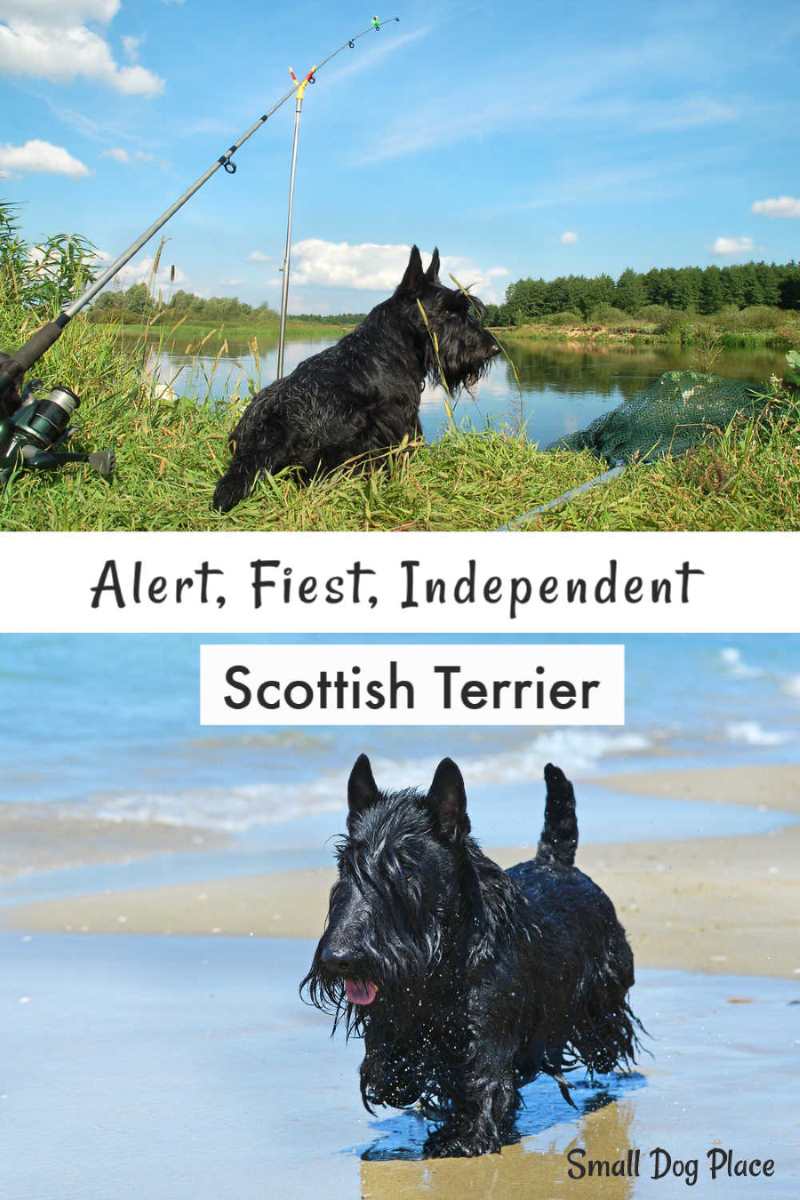 Scottish Terrier Pin
Scottish Terrier PinResources and Further Reading
Scottish Terrier Club of America
Canadian Scottish Terrier Club
Does This Article Deserve Your Thumbs Up?
We always appreciate your support and encouragement. Your thumbs up means so much to us.

Free Monthly Newsletter
Sign Up for Our Free Newsletter and get our Free Gift to You.
my E-book, The Top 10 Mistakes People Make When Choosing a Dog (and how to avoid them)
If you enjoyed this page, I’d love it if you’d let me know. Just click the button below. Thank you.
Sharing is Caring


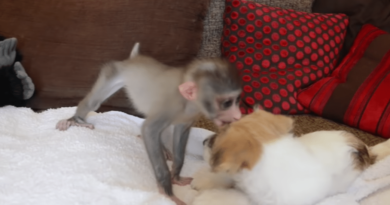


First of all, thank you for your post. baccaratsite Your posts are neatly organized with the information I want, so there are plenty of resources to reference. I bookmark this site and will find your posts frequently in the future. Thanks again ^^